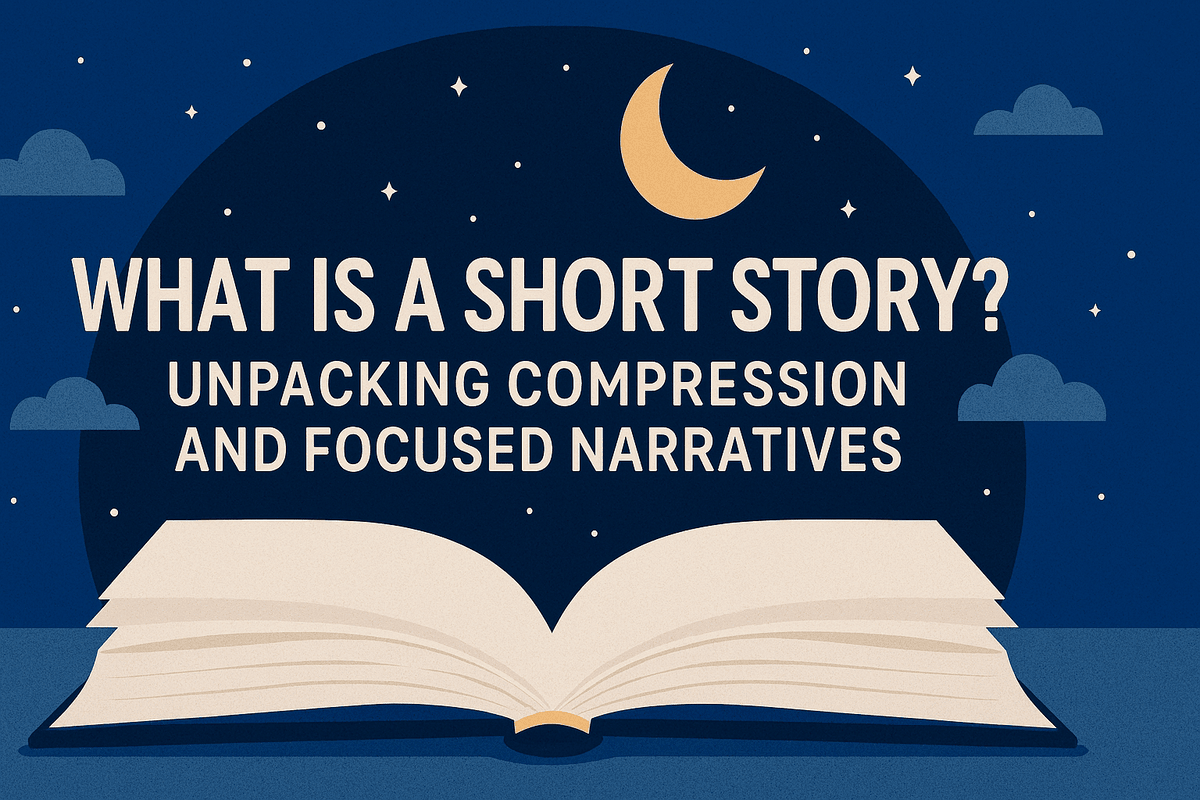Have you ever picked up a book and finished it in one sitting? That quick, powerful experience is often the magic of a short story. This special form of writing pulls you into a complete world, then lets you go, all in a short time. Despite its smaller size, a good short story delivers a big impact, often sticking with you long after you read the last word.
But what makes a short story truly short? It is more than just a low word count. We’ll explore the real craft behind these tales. We’ll find out what makes them resonate, especially compared to longer books, focusing on how they fit so much meaning into so little space.
Defining the Short Story: More Than Just a Short Novel
A short story is a stand-alone work of fiction. It presents a complete narrative piece. This makes it different from a chapter in a novel, which is only part of a bigger tale. Its self-contained nature gives it a unique power for readers.
What Makes a Short Story Short? Word Count and Intent
Most short stories fall between 1,000 and 7,500 words. You might see some as short as 500 words or as long as 15,000 words, but those are less common. Literary magazines, like The New Yorker, often publish stories within this range. The word limit isn’t just a rule; it shapes every choice the writer makes. This forces them to focus their narrative sharply.
Key Characteristics: Distinguishing Features of the Form
Beyond word count, short stories have clear traits that set them apart from book and other pieces of liderature. They typically feature a limited cast of characters. The plot is usually very focused, often exploring a single major event or conflict. Settings are also often kept to one main place, or a few linked locations. These elements help keep the story tight and impactful.
Compression: The Art of Saying More In Less Words
Compression is a fancy word for packing a lot of meaning into a small space. Think of it like a dense fruit cake; every bite is full of flavor. Short stories use compression in characters, plot, and themes to achieve their powerful effect.
Character Compression: Developing Depth Quickly
Short stories make characters real fast. Authors don’t have chapters to show someone’s whole life. Instead, they focus on key traits or a moment that changes everything. We see how actions affect them, not a long history. Take Mrs. Mallard from Kate Chopin’s “The Story of an Hour.” We spend only a few pages with her. Yet, we understand her deep desire for freedom through her thoughts and a single, sudden change in feeling. This quick, deep look is a hallmark of good short fiction.
Plot Compression: Driving Towards a Single Effect
Plots in short stories are lean and simple. They trim away extra parts. Each event moves the story forward to one big moment or important thought. There are usually no side plots or detours. For writers, it means finding the core problem. Then, you cut anything that doesn’t push that main conflict ahead. This keeps the reader hooked from start to finish, driving towards a clear end.
Thematic Compression: Unpacking a Central Idea
Short stories often zero in on one strong theme or idea. This narrow focus lets the author explore it deeply within the limited pages. It is like looking at one thing through a magnifying glass, seeing all its small details. Edgar Allan Poe, a master of the form, talked about “unity of effect.” This means every part of the story should work together to create one strong feeling or idea for the reader. This concentrated focus gives the story greater power.
Concentrated Narrative: Focusing the Reader’s Experience
A concentrated narrative means the story aims to keep your attention on what matters most. Every word, every scene, works hard. Nothing is wasted. This tight focus makes the reading experience intense and direct.
Setting and Atmosphere: Creating Impact Through Economy
Settings in short stories are chosen with care. They set the mood and help the story without needing pages of description. Each detail must do a job. Think of the isolated house in Poe’s “The Tell-Tale Heart.” Its dark, quiet feel boosts the tension and the narrator’s madness. The environment isn’t just background. It actively makes the story more scary or meaningful.
Pacing and Structure: Accelerating Towards Significance
The pace of a short story often feels faster. The story quickly builds to a peak. The ending might wrap up fast, or even leave you thinking with no clear answers. Short stories use a tight structure. This means the start grabs you, the middle moves swiftly, and the end hits hard. Pay close attention to how a story begins and ends. These parts often carry the most weight. They set the tone or leave a lasting image in your mind.
Dialogue and Narration: Efficient Revelation
In short stories, every bit of talk and every sentence of narration matters. Dialogue reveals who characters are and moves the plot. Narration gives you key information quickly. Authors can’t spend pages telling you everything. Instead, they pick words that show a lot with a little. Think about how a novel might give long explanations. A short story will use a sharp line of dialogue or a brief description to do the same job.
Short Stories vs. Longer Fiction: A Comparative Analysis
Short stories and novels are both amazing ways to tell a tale. But they play in different fields. Understanding these differences helps us appreciate each form.
Scope and Ambition: Different Arenas for Storytelling
Novels let writers build whole worlds. They can follow many characters, show long journeys, and explore big ideas. Think of a big, sprawling map. Short stories are like a close-up photo of one key spot on that map. They focus on one event or a specific change. A novel might take days or weeks to read, asking for a big time commitment. A short story usually takes less than an hour, offering a quick, intense experience.
Impact and Resonance: The Lingering Effect of Brevity
The tight focus of short stories often leads to a strong, immediate punch. They can leave a deep feeling or a clear idea in your head. They stick with you. Take Shirley Jackson’s “The Lottery.” This short piece caused a stir when it first came out. People still talk about its shock and themes of tradition and cruelty. Its brevity helps its lasting power.
Conclusion: The Enduring Appeal of the Concise Narrative
Short stories prove that good things often come in small packages. They show the amazing power of focused storytelling. Through compression, they pack rich characters, tight plots, and big ideas into a few pages. Their concentrated narrative keeps readers engaged, making every word count. So next time you see a collection of short stories, give it a try. You might find a whole world of thought-provoking tales waiting for you. Dive into these short, powerful journeys and see what lessons they offer.

